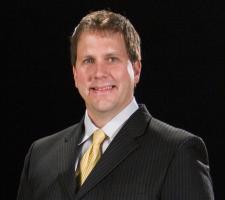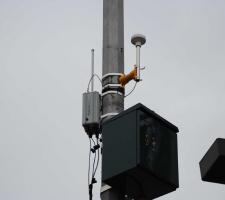
At the 2008 ITS World Congress held in New York in November which was, Kapsch mounted live demonstrations of 5.9GHZ DSRC-based tolling transactions; the company is keen to underline that 5.9-based systems and a technological migration path already exist
Justin McNew, Chief Technology Officer, Kapsch TrafficCom Inc., USA offers his opinion of where 5.9GHz DSRC technology will head in the coming years.
The debate ranges back and forth over the most suitable technological solution for future tolling and charging in the US. However, the coming trend is common cooperative infrastructure: instrumented roads and vehicles with the capacity to communicate with each other over all manner of safety, mobility and traveller applications, many of which will involve financial transactions.The US cooperative infrastructure effort is embodied in the long-established
The IntelliDrive approach
Kapsch, a long-term player in the international tolling and charging sector, is turning its attentions to the US tolling market. At the 2008 ITS World Congress, the company was at pains to demonstrate to the domestic market that 5.9GHz-based technology is already a reality and that there is a credible migration path already in existence. In doing so, the company is looking to challenge what it sees as the complacent attitude of domestic tolling system suppliers who have long been able to enjoy the benefits of tied customers and proprietary solutions.Justin McNew, Chief Technology Officer,
"5.9GHz DSRC offers a smart solution for advanced safety roadside operations. Unlike a number of proprietary technologies, it is a common technology that enables information-sharing between vehicles and between vehicles and the roadside. We have achieved interoperability but who is willing to pay for interoperability to improve safety and mobility? Given the current economic climate, the US Department Of Transportation [USDOT] is not in a position to fund safety and it's not exactly a private-sector business initiative either, which means that payment applications such as electronic open road tolling and urban charging are absolutely critical to the IntelliDrive programme's success. Tolling is just one application but it has the ability to unify a whole series of outdated, custom-built solutions." For the US, which knows it needs to move from proprietary technologies which do not support open standards, 5.9GHz DSRC tolling is a reasonable next step, he says: "I see an obvious gap in the current US tolling standards for vehicles passing gantries at high speeds," McNew continues. "5.9GHz DSRC will not only fill that gap but in doing so will become the first open standard for North American electronic tolling." He points to the technical advantages of a move from current-generation megahertz to a next-generation gigahertz-based solution.
"5.9GHz DSRC allows for vehicle-to-roadside communications at much longer ranges than the current 915MHz automatic toll systems, with much higher speed and data throughput - up to 27Mb/s, greater security and vehicle-to-vehicle exchanges.
"915MHz DSRC/RFID technology has been proven in the moving vehicle environment. Nevertheless, the effective range of existing 915MHz DSRC/RFID is typically less than 30m and the data rate and applications are limited. This bandwidth limitation could significantly affect the size and complexity of the safety data message set for commercial vehicles and could result in reduced inspection data, a possible need for onboard compression, and the need, as more safety and mobility applications come online, for slower vehicle speeds or multiple access points in order to transmit more data.
"For me, 5.9GHz DSRC is the ideal for high-performance tolling in the US - and it will be the solution for city parking, transit and commercial vehicle applications. Mobility solutions entail a number of applications, one of which is tolling. It's reasonable to look to combine applications in one device and the only way to equip a workable percentage of the vehicle fleet within a reasonable time is through aftermarket installation.
"If the US proceeds with the IntelliDrive programme approach demanding safety and interoperability, and I think it will, it sets a national and international benchmark. In time, I think we'll see 915 tolling disappear."
Paying for future roads
McNew sees a clear migration strategy for 5.9 GHz DSRC technologies - a crucial part of the equation if any such shift is to have a realistic prospect of occurring. Kapsch is proposing a combination of its 5.9GHz DSRC products and video to enable a smooth transition from existing 915MHz technology for toll authorities in the US."The introduction of 5.9GHz DSRC aftermarket transponders which can be read alongside the existing 18 million or so 915MHz transponders would allow a faster changeover to the newer, higher-frequency, more secure and faster technology, while allowing the existing transponders to continue to be used. The 5.9GHz DSRC retrofit transponders will be about the same size as current 915MHz-based transponders and will also cost roughly the same. Low-cost, easy-to-install 5.9GHz DSRC devices are a matter of months and not decades away," McNew states.
"I think that 5.9GHz DSRC Electronic Toll Collection [ETC] deployed nationally on highways, arterial roads and in urban corridors will provide the answer to the lack of maintenance funding for existing roadways. 5.9GHz DSRC will also be used for tolling of urban corridors, enabling cities to collect local revenue while at the same time making way for active safety applications such as intersection collision avoidance and emergency signal pre-emption/signal timing optimisation. The added benefits of a 5.9GHz-based ETC system would enable ramp metering on highways and support smart parking solutions without the need for expensive and hard-to-maintain loop detectors or any other kind of trigger devices.
"5.9 GHz DSRC deployment has the potential to expand to nearly four million miles of roads and highways, nearly 600,000 bridges, almost 78,000 transit vehicles, approximately 11,000 miles of transit track-miles, and nearly 3,000 transit stations. The revenue potential for cities and states is enormous. I don't see a lot of other compelling technologies that provide the same potential to create jobs, improve roads or increase safety." Increasing the level of gas tax could provide one solution to the current infrastructure funding problems. However the reality is that this is politically unpalatable, especially in the current economic climate.
"The current gas tax that has been in place since the 1970s is failing to cover the cost," McNew continues. "The Inter Agency Group (IAG) already generates approximately $4bn per year from tolling revenue. That would increase with the implementation of 5.9GHz DSRC if the IAG were to allow toll tags to be used to pay for other commercial services. As a consequence of the credit crisis, and with the cost of raw materials from the developing world rising sharply, it's likely that the Federal Government and state agencies will be unable to improve infrastructure or borrow money to improve roads and highways without a robust ETC and ITS solution based on the newer technology."
Stakeholder investment and early adoption
Kapsch and other industry stakeholders, including many of its primary competitors in the US, have participated in development of USDOT-sponsored 5.9GHz DSRC standards for IntelliDrive/VII.One of the major successes of the standards development process has been the concurrent development of products from a number of private companies. Kapsch's 802.11p-based solutions are specifically designed for use in high-speed vehicle environments (critical for pass-by of toll gantry at high speeds as well as crash-avoidance applications) and are based on WiFi. This is in order to take advantage of quantities of scale, the aim being a low-cost chipset adapted for applications which require low-latency access such as tolling and crash avoidance. The IEEE 1609 standards which build on 802.11p support critical security and privacy services for applications and management messages networking services, and multi-channel operations. Kapsch's Multiband Configurable Networking Unit (MCNU) has been successfully deployed in a number of testbeds which utilise the standards and facilitate further standards development.
"We already see where communications between tolling and navigation devices which include GPS will become necessary for safety and traveller information. A number of leading companies and government agencies are looking at 5.9GHz DSRC to better understand the benefits in terms of probe data collection, in-vehicle signage, traveller information, emergency signal pre-emption, variable message signs, traffic and transit monitoring, and parking solutions." Government and industry stakeholders are also evaluating 5.9GHz for Commercial Vehicle (CV) applications as it relates to emissions reduction, operational efficiencies and electronic inspection and credentialing. The Federal Motor Carrier Safety Association (FMCSA) has stated that CV numbers and mileage grow each year increasing fuel consumption, while roadside safety inspection resources remain constant due to current inspection technologies that are limited in their ability to address wireless roadside inspections.
Automotive OEMs, their suppliers and key stakeholders are evolving to provide more and better information to the driver using 5.9GHz DSRC technologies. But only those smart solutions that also generate revenue for the road operators will enable the informational services necessary for a funded and cooperative infrastructure.
"Cooperative infrastructure will become universal when the technology becomes a commodity - when users can install it in their vehicle as an aftermarket onboard unit and pay for it as they do for a toll tag, or when it is integrated into existing in-vehicle devices," says McNew.
"However, any safety or interoperable technology choice and the rate of migration will be driven by the need for funding of the transportation infrastructure. At present, the USDOT has sent a clear message that safety and interoperability are a priority and I think that means a lot of opportunity for 5.9GHz DSRC in the coming years."













